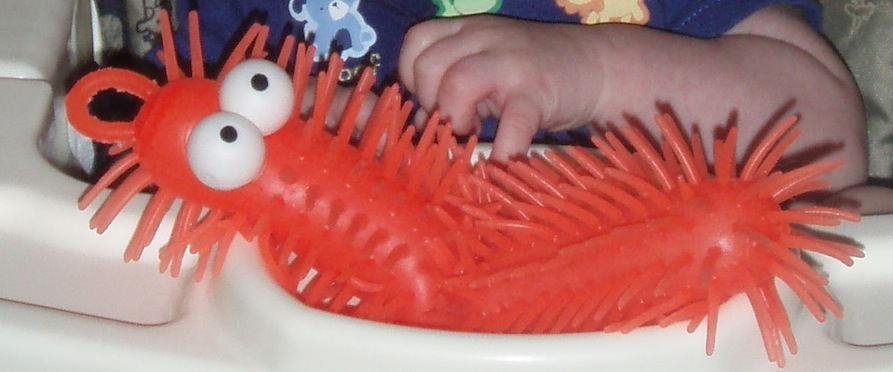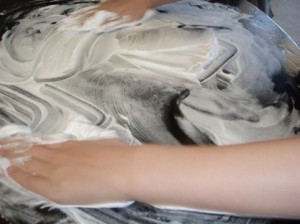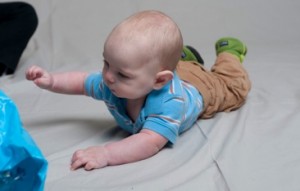I lump this age group together to emphasize that real handwriting should NOT begin before this age. Even older children, three to four year olds, should emphasize all the strategies layed out below. CHILDREN ARE NOT DEVELOPMENTALLY READY TO LEARN HANDWRITING UNTIL THEY ARE FIVE-SIX YEARS OLD.
This has nothing to do with intelligence. It has everything to do with how the nerves and muscles develop in the hand. When we encourage children to write before their hands are anatomically ready, they develop bizarre methods to hold a crayon, pencil, etc. Once they learn a particular grasping pattern, the habit is formed and it is difficult to change.
That’s why children entering Kindergarten with very little handwriting practice find it easier to learn how to hold a pencil correctly and then become proficient early writers.
I met a little boy in a Kindergarten who hadn’t a clue how to hold a pencil in September. He worked on hand strengthening and other sub skills for writing over the course of the fall…learning carpentry, weaving and many other fun activities. Come January when I visited his class again, he proudly stated, “I will use lower case letters (more difficult) to write this because I’m in Kindergarten now.” His control of the pencil and letter formation were impressive! Most important, the pride in his voice with his new found prowess for writing was crystal clear!
Having said all this, there is plenty you can do everyday, starting with the day your child is born to build the foundations necessary for eventual writing. The following reviews key components to develop good fine motor dexterity and the ability to push that pencil with skill.
- Touch awareness is key. We feel how our fingers move on an unconscious level all the time. We think of the muscles and eyes doing all the work, but our touch system plays a big role in how we engage with objects. Think how clumsy we are when we try to work with ill-fitting plastic gloves. The touch system is very much alive and gathering information from birth on!
- The muscles in the fingers, hands and arms are very important. This is where development comes in. Many of the smaller muscles are not neurologically “scheduled” to activate until the 4th-5th year of life. So, prior to 4-5 years old, children do not have the necessary motor control to hold a writing tool correctly.
- Muscle strength and touch awareness lead to the ability to move each finger individually. This also moves on a developmental time line. You do not expect a toddler to successfully snap their fingers.
- Children need to sit up comfortably for extended periods: 5-15 minutes. This requires solid core strength.
- Visual attention is critical to guiding the little hands in learning how to draw lines, circles etc.
- Visual perception and spatial reasoning are important to understanding how to combine strokes and curves to form letters.
That’s quite a list…so you can see there is quite a bit of playing that can go on that builds the potential for great handwriting without ever holding a pencil!
Here are some examples of how you can start building hand writing skills on the day your baby is born:
 When the newborn is placed in your arms, you will naturally try to establish eye contact. Studies show that the infant will actually try to obtain the parent’s visual attention as well! This begins the development of focused visual attention.
When the newborn is placed in your arms, you will naturally try to establish eye contact. Studies show that the infant will actually try to obtain the parent’s visual attention as well! This begins the development of focused visual attention.- When you place a finger in the palm of the baby’s hand, the fingers automatically close tight, thanks to the grasp reflex. While this is a “primitive reflex” and fades away as voluntary movement develops, the motion activates hand muscles, which in turn initiate strengthening of muscles.
- Gently rocking and cuddling the newborn activates centers in the brain that help regulate attention and motor control.
Here are some examples of how you can prime your baby and toddler for later writing assignments:
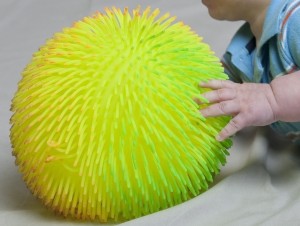 Provide ample opportunities for touch exploration. Examples may be, playing with food on the high chair tray and smooshing foamy soap around in the tub. Each time you encounter an object, verbally identifying it (language development). Have the child look at it (visual attention) and THEN TOUCH it (Tactile discrimination).
Provide ample opportunities for touch exploration. Examples may be, playing with food on the high chair tray and smooshing foamy soap around in the tub. Each time you encounter an object, verbally identifying it (language development). Have the child look at it (visual attention) and THEN TOUCH it (Tactile discrimination).- Engage in simple hand play activities ALL the time. Waving bye bye, “Open Shut Them..” “How big is…” and POINTING all help bring awareness to the hands and fingers. This helps the child learn how to move each finger individually, a very important skill for efficient writing.
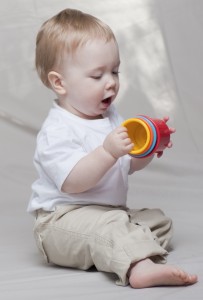 Squeeze toys, poking toys and all other manipulatives help to increase strength and early dexterity in the hands.
Squeeze toys, poking toys and all other manipulatives help to increase strength and early dexterity in the hands.- Holding all sorts of objects (Keep in mind that they should not be small enough to swallow and also safe), helps the hand learn how to mold around different shapes, sizes and weights. This activates different muscle groups in the hands.
- Playing on the floor, especially engaging in “Tummy Time,” will help strengthen core muscles necessary for table top tasks when in Preschool, Kindergarten and beyond.
- Provide many opportunities for visual exploration. Books, puzzles and interesting toys are just a starting place. Use your environment. Point out square windows and round plates. Note when things are pointy. Go outside and search for tiny ants and pebbles. Discuss their qualities, visual and tactile.
 Whenever playing, encourage your toddler to use both hands. This helps to develop bilateral motor coordination.
Whenever playing, encourage your toddler to use both hands. This helps to develop bilateral motor coordination.- Make sure when playing your child is looking at the object or action occurring. This helps establish the eye hand connection, so important for eye-hand motor coordination and visual motor work (like writing!).
Here are some ideas for the Precocious two year old who can’t wait to draw and write:
-
Tactile exploration continues but with finger paints, foamy soaps, maybe tinted pudding.
- Hand strengthening begins in earnest with play dough, clay and Duplo type construction toys.
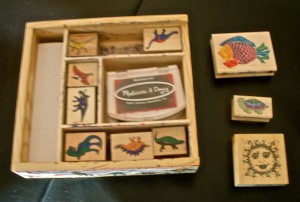 Stamping out pictures with wooden stamps strengthens the hands while allowing for the expression of creative genius.
Stamping out pictures with wooden stamps strengthens the hands while allowing for the expression of creative genius.- If they must draw, use large side ways chalk placed on the side so two hands push the chalk around with the finger tips. Encourage the same with crayons.
- If using markers be sure they are fat ones. (Mr. Sketch provides olfactory input).
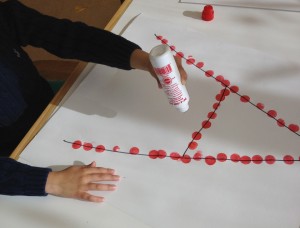 Dot art is another great substitute for artwork.
Dot art is another great substitute for artwork.- Refer to all of the Infant and Toddler suggestions above, BECAUSE these are all very important foundations still developing!
To gain a full understanding of these “Sub-skills,” refer to the following sections:
- Core Strengthening
- Hand Strengthening
- Fine Motor Dexterity
- Tactile
- Eye-Hand Coordination
- Bilateral Motor Coordination
- Visual Motor Skills
Each section has many activities to target these skill areas!
